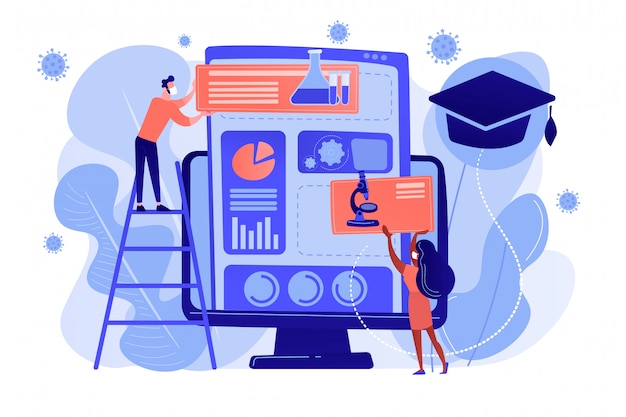Research has established that micro-learning is best-suited for the current millennial workforce, which has minimal attention spans. It is vital to provide them with information at a rate that matches their ability to focus. Microlearning improves learning transfer by 17% as compared to traditional learning methods. It leads to 50% more engagement and cuts down development costs by 50% — Guide2Research.
When you say ‘Microlearning,’ you should not merely use it to augment your existing training materials. It would be best if you opted for an all-inclusive curriculum, which covers all your enterprise requirements. In short, rather than stand-alone modules, you SHOULD think of a full-fledged ‘Enterprise-oriented’ course. And this means that you SHOULD pay special attention to content generation and instructional design. After all, converting vast amounts of content into bite-sized chunks is not child’s play!
The question is, what should you consider while choosing an all-inclusive microlearning LMS? We recommend eight vital elements that you MUST include in your microlearning platform.
Table of Contents
8 Crucial Parameters to Consider Before Choosing a Micro-learning LMS
Mobile First

What are the primary end goals of a microlearning platform? Design content that’s brief, engaging, and most importantly, responsive. By responsive, we mean the ability to access the training modules from multiple devices. The modern learner likes to absorb whatever they can, whenever and wherever they can. They generally use smartphones and tablets to access information at their pace.
Therefore, your microlearning module MUST adopt a responsive design approach. It ensures that your training materials work flawlessly and look perfect on any hand-held gadget. One can customize a responsive course to fit over any screen size as per the requirement. Mobile-ready content is vital when flexibility is the primary goal of your digital micro-training experience.
An Interactive Experience

Since microlearning keeps learners engaged for short time frames, it needs to pack in a punch with interactive elements. Interactivity enables trainees to apply their theoretical knowledge, using practical examples. It helps them in retaining the information for a longer duration.
Some of the tried and tested interactive elements that produced good results are simulations, drag-and-drop interactions, e-learning games, and clickable walkthroughs. Most of these activities offer immediate feedback, enabling learners to rectify mistakes and continually improve their performance curve instantly. There is always the option to repeat a particular exercise when required, leading to a gradual improvement in the problem-solving approach.
Webcasts & Live Classes

Videos are one of the best tools to explain a process that involves complex equipment or skills, best demonstrated via lengthy documents. In this case, the ideal method is to opt for micro-clips. Several small clips, with each of them tackling a targeted topic, can be clubbed into a single curriculum. However, to attract a learner, the videos must be engaging — complete with closed captions, graphics, mobile-optimized displays, and animations.
Whiteboard animations and kinetic typography are a few tried and tested formats of video learning. However, you can go a step further and make your lessons more inclusive by incorporating live demos or classes and webcasts. Webcasts are live presentations and conferences conducted using online conferencing tools. On the other hand, you can segment live courses into bite-sized nuggets to cover one objective. Interactive videos are another tool that enables trainees to interact with the clip through click-and-reveal interactions, linked external resources, and others.
The Assessment Factor

When you deploy a microlearning module, how do you track the progress of your learners? Well, with the help of a strategy that provides a timely assessment. But for this, you need to define your training program’s objectives first clearly — what do you want your employees to know or do? Of course, you can then test their knowledge with a quiz uploaded into the LMS. To measure targeted objectives, you can use short tests, brief assignments, or score-based games to measure the learner’s proficiency. When a trainee successfully clears the test, your module can include rewards like credits. After all, finishing a course without proper feedback or review is pointless.
In short, your microlearning MUST incorporate the three Ms — Mobilizing Microlearning Measurement. Decide what you want your learners to gain from your microlearning units. Next, develop short but concise corresponding assessment tools. Finally, measure their progress as per your requirements.
Discussion Forums

Online discussion forums are a powerful medium for online micro-training. Why? These platforms promote collaborative learning. Interactions between the mentor and learners or between peers are vital to share thoughts and ideas. Once learners discuss a specific topic, they gain deeper, newer insights on the subject.
With the help of a well-designed micro-learning LMS, you can create chat and discussion forums for each course. Certain LMSs also integrate social learning sites, leading to increased levels of interactions. The final results are the free exchange of ideas among people from varied backgrounds, creating message threads, improved quality of dialogue delivery, and the facilitation of self-learning.
Integrated LCMS

When you pick a microlearning platform, ensure that it has LCMS (Learning Content Management System) integration. While a micro-learning LMS concentrates on managing learners, tracking their progress, reporting to HR, and other ERP systems, an LCMS is heavily geared toward learning content. Authors, instructional designers, and subject matter experts can efficiently create bite-sized content chunks.
LCMS enables you to generate content that instantly covers targeted subjects. The designers create reusable e-learning modules and then assemble them to create customized courses. It removes the need to create an entire curriculum and then make it adaptable to different audiences. It also removes the instances of duplicate content creation. Therefore, experts recommend going for a microlearning LMS, which enables easy LCMS integration.
xAPI & SCORM Compliance

The Experience API (Application Programming Interface), aka xAPI or TinCan, enables you to collect data from a gamut of learner experiences – both online and offline. This online micro-learning LMS standard captures data from multiple group activities and delivers them across various platforms. The TinCan protocol allows learners to interact with published content and learning events. The LRS (Learning Record Store) subsequently records these activities and can reshare the learnings over other LRSs.
xAPI additionally allows you to reuse legacy artifacts such as existing PPTs, leaflets, or Word files — so that you can convert them into bite-sized e-modules. xAPI is an excellent choice when you plan to use e-learning tools like HTML authoring software. However, if you wish to adopt a traditional approach, you can go for a more well-established standard like SCORM (Sharable Content Object Reference Model).
Irrespective of the type of existing content (xAPI or SCORM), your Micro-Learning platform must be able to reuse your legacy learning content without the need for a massive recreation effort.
Insightful Analytics
To measure the impact of microlearning on learners, you must keep track of their learning activities. You can analyze the data gathered through tracking tools to gain actionable insights. This is where the inbuilt analytics feature of a full-fledged microlearning LMS comes into play. For instance, the availability of a progress dashboard gives you a real-time view of your learners’ performance. You can then make informed decisions quickly.
If you choose a micro-learning LMS platform like PlayAblo, you get an aggregate view of learner data in terms of:
Usage – Time spent on the platform.
Progress – No of learners who have completed the course, not completed or partially completed.
Performance – Measure learning outcome by comparing the pre-assessment, ongoing and post-assessment scores.
Conclusion
For the modern, versatile learner, microlearning is the perfect medium to break the monotony of boring, one-sided training programs. If designed correctly, it serves as a useful, long-term tool for your organization. Although there is no proven formula on what will work or what won’t for your company, the parameters mentioned above are a universal must-have for any microlearning LMS.







7 Comments